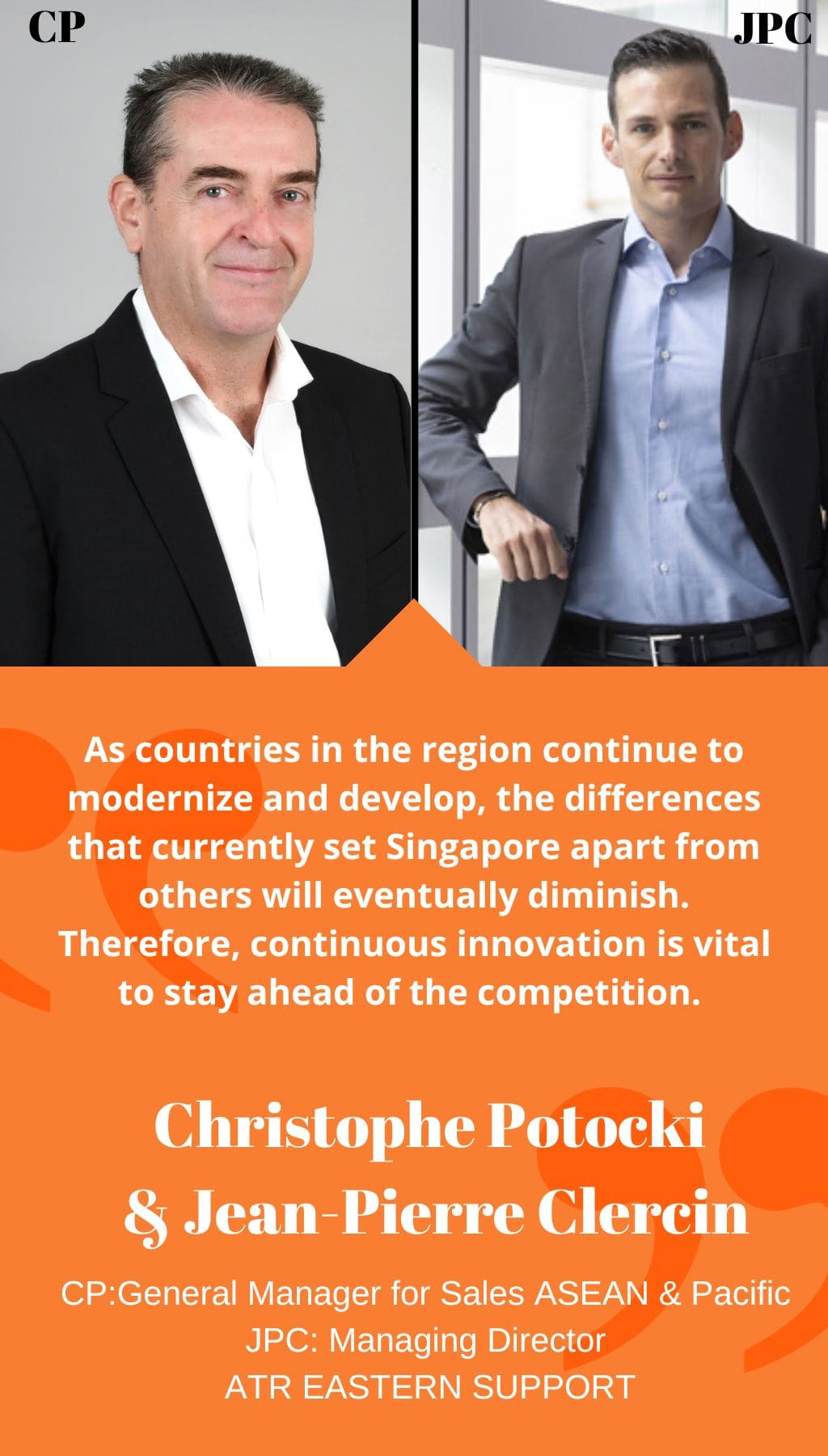
- Singapore | 14 June 2019

Can you please share a brief history of ATR internationally and explain why it was important to establish operations in Singapore?
CP: ATR was established in 1981 as a joint venture between Airbus and Leonardo in Toulouse, France. Over the past 35 years, we have delivered more than 1,358 aircraft to almost 200 customers in around 100 countries. In many regions, particularly in Asia, turboprops are the only feasible means of transportation between different locations. Regional aircraft must be capable of operating in any severe or restricted environment, such as short and/or narrow runways, high altitude airports, semi-prepared airfields, and extreme temperatures. This market is enormous globally, with regional aviation accounting for 25% of the fleet.
JPC: Our mission at ATR is to connect communities and promote sustainable growth with our turboprop aircraft, just like we do worldwide. Asia is the world’s fastest-growing aviation market, and ATR has been fortunate to achieve tremendous success in the region. Today, ATR operates a fleet of 377 aircraft in Asia Pacific, operated by more than 50 customers and operators in 22 countries. It is crucial for us to demonstrate our long-term commitment to our operators by having a strong (and expanding) services presence that is close to them.
Could you please explain the origins and service offerings of ATR Singapore and outline your operations with the ATR Singapore Training Centre?
CP: ATR Singapore (AES) was incorporated in 1996 and is wholly owned by ATR, the world’s leading turboprop aircraft manufacturer. Despite the global economic challenges, we have continuously maintained our presence in Singapore to support our customers in the region. Singapore has 50 talented AES employees. In Asia Pacific, loyalty and dependability are the most important qualities that customers seek, and these values are critical within ATR.
Our primary activities in Singapore focus on customer services. AES offers a wide range of services, including training solutions for pilots and engineers, technical support (repair solutions/troubleshooting), and spare parts support (inventory management/power-by-the-hour system for maintenance [GMA]). In 2013, we invested in a multimillion-dollar training complex in Seletar Aerospace Park, together with Singapore Technologies (ST), to establish an ATR 72-600 Full Flight Simulator. It took us six months to go from zero to housing an ATR simulator. ST has done an excellent job managing this incredibly successful project. Today, ST’s simulator operates over twenty hours per day. Our sales teams in Asia Pacific are also based in Singapore.
What was the reasoning behind opening a training center in Singapore, and what are ATR Singapore’s international growth targets?
JPC: According to ATR Market Forecast, the Asia Pacific region will need over 1,000 aircraft in the next 20 years. All of these aircraft will require pilots to fly them. To meet the demand in the rapidly expanding Asian market, having a dedicated training center was critical for us.
CP: Currently, there aren’t enough training centers in the Asia Pacific. Asia accounts for a third of our global fleet and has over 50 customers and operators. ATR pilots are, therefore, in high demand in the region. We deliver a third of our aircraft to customers in Asia Pacific, particularly in emerging markets such as Indonesia, Myanmar, Malaysia, the Philippines, and other areas that require inter-island operations.
What is your opinion regarding the existing regulatory framework in Singapore that promotes growth and development in the aerospace industry? Are there any areas that require improvement?
CP: From my experience, I can confidently say that Singapore is committed to making positive changes to facilitate economic growth. As a business hub in the Asia-Pacific region, it offers excellent opportunities for companies to expand and reach out to customers. ATR Singapore, for instance, received support from the EDB in the form of a tax scheme for one of our multi-party projects, which helped us to grow our business. The government has been successful in creating a favorable environment for industrial firms like ours.
JPC: I believe that Singapore encourages a pro-business ecosystem, which is evident in the aerospace cluster in Seletar. The government has been instrumental in attracting major players in the industry to a single location, which is a significant advantage. However, sourcing skilled labor remains a challenge, and as such, there is a need for new courses and university partnerships.
What advice would you offer to other companies that want to establish operations in Singapore, and what are your plans for ATR Singapore in the future?
CP: As countries in the region continue to modernize and develop, the differences that currently set Singapore apart from others will eventually diminish. Therefore, continuous innovation is vital to stay ahead of the competition. ATR Singapore is committed to developing new technologies and creating innovative solutions for our clients. Presently, we are focusing on the creation of a low visibility navigation system.
JPC: I agree with my colleague that innovation is key to success in the industry, and I would advise other companies looking to operate in Singapore to prioritize it. As for ATR Singapore, we aim to continue to grow and expand our operations in the region while remaining at the forefront of technology development.














